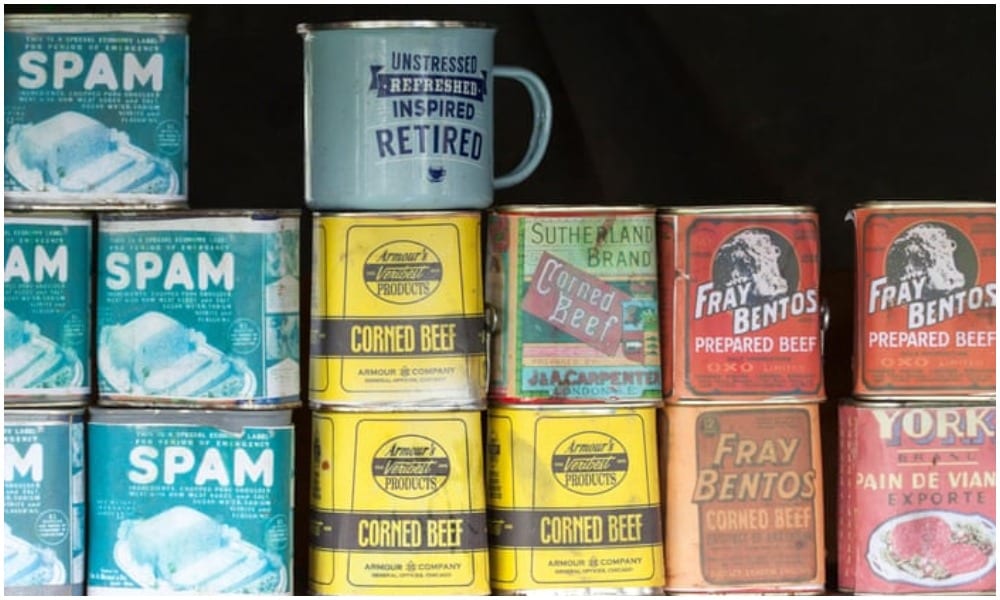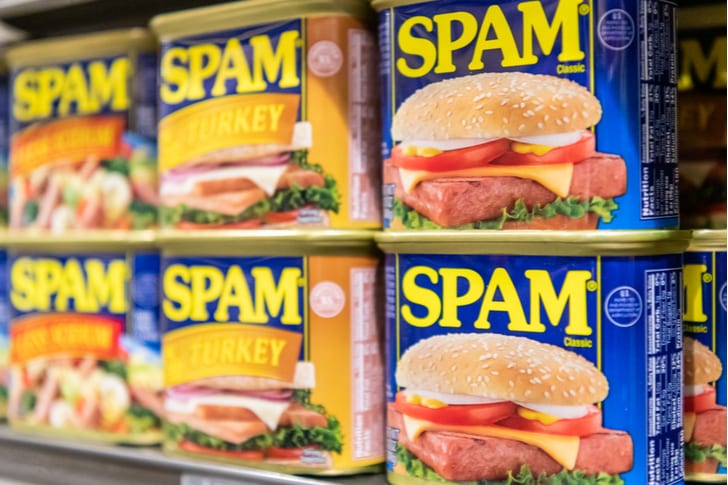
The Culture of Spam – From WWII to the Present Time

From Hawaiian-Korean fusion dishes to Pacific Islander cuisine, there is not a single place left that hasn’t embraced Spam’s use. For this reason, many Asian-American chefs are trying to bring the processed meat into American dining, but the world is divided when it comes to these canned goods.
Why is that? The question might sound unnecessary, but the history of Spam reveals the truth behind the beloved meat. We’re hoping this could shed some light on why this product has been around for more than half a century!
The First Can of Meat

Julie Clopper/shutterstock: Spam has been around for almost a century
Salt, sugar, water, pork, and sodium nitrite- these ingredients were mixed together in 1937 to create Spam. Hormel Foods Corporation was the first to conduct this experiment, but the product didn’t get attention until the second world war started.
When US troops were deployed in the Pacific, they always had Spam with them. It was not part of the official ration, yet, everyone preferred it to any other food item because of its convenience and ease of use.
As the destruction started to affect every other country, Spam was the savior at the time, especially in Europe and Asia, where people were trying to survive in the post-WWII period.
Home-Cooked Meals

Irina Kovynyova/shutterstock: Use of Spam in home-cooked meals
After it became an international staple, Spam was a household product used in home-cooked foods. The thought that an American product would become so popular in the Asian countries was incomprehensible, yet the hunger and poverty led the nations to rely on canned meat.
People of Japan, Korea, and even Britain accepted the new change and incorporated it into their everyday life. The sadness and desperation associated with Spam were evident in the early days after WWII, but internationally, it was a success despite what the developed countries thought.
Birth of Spam Stigma

calimedia / Shutterstock
Spam isn’t popular in every part of the world
As time passed, Britain was able to recover fast economically, while the Pacific-Asian countries had to face financial failures for a while. This, too, contributed to the use of Spam in their cuisine.
A processed alternative for meat became a disgrace in many parts of the world, and high-end chefs started to refrain from using it. They considered it a cheap option for food, and its use became shameful for food geniuses.
The international debate of whether it was good to use Spam has continued until the current age. It took a while, but most chefs and cuisines have adapted to the new ways of meat manufacture and appreciate the change in taste.
Experts say that Asians have contributed a lot to the American food industry, and now the mixture has become so strong that it is hard to distinguish whether it is an Asian or American phenomenon that has changed the way canned products are viewed in the world.
More in Culture
-
`
Council Adopts ‘Listing Act’ to Streamline Listings on the European Stock Exchange
In a landmark decision, the Council has officially adopted the “Listing Act,” a comprehensive legislative package designed to revamp and streamline...
October 18, 2024 -
`
Sophie Turner Shares Her Daily Struggles as a Single Mother
Sophie Turner recently opened up about her immense challenges as a single mother. The 28-year-old British actress, known for her iconic...
October 12, 2024 -
`
How to Align ESG Goals With Your Business Strategy
In today’s corporate landscape, aligning a corporate foundation’s ESG goals with the core strategies of a business has become increasingly crucial....
October 3, 2024 -
`
Vale Ventures to Invest in Mantle, A Startup for Carbon Capturing
In a bold move towards a greener future, Vale Ventures has made headlines by announcing an investment in the Boston-based startup...
September 25, 2024 -
`
Is Selena Gomez a Billionaire?
Recently, rumors of Selena Gomez’s billionaire status, fueled by her ever-expanding business ventures and skyrocketing influence, have gained traction. Gomez, who first...
September 18, 2024 -
`
New ‘Medicare Card’ Scam Is On the Rise – Here’s What You Should Do
Have you recently received a call asking you to verify your Medicare number to get a new card? If so, be...
September 13, 2024 -
`
What Is a Stock Split? Understanding How It Works
Stock splits are a fascinating aspect of the financial world that often pique investors’ curiosity. When a company announces a stock...
September 6, 2024 -
`
Cardi B No Makeup: Proof That She’s a Natural Beauty Queen
Cardi B is known for her bold and extravagant style, often capturing attention with her vibrant fashion choices and daring beauty...
August 31, 2024 -
`
How Long Has Forbes Been in Business? – And What Lies Ahead
For over a century, Forbes has been a pillar of business journalism and financial reporting. Since its inception in 1917, Forbes...
August 21, 2024















You must be logged in to post a comment Login